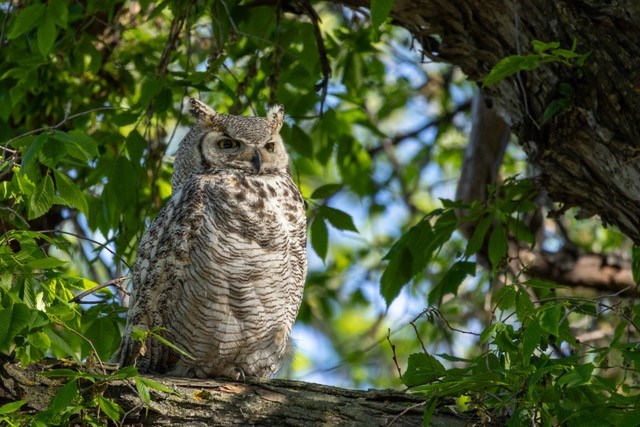SASKATOON - For owl intents and purposes, the Living Sky Wildlife Rehabilitation organization needs students to become involved in more than their studies.
A social media post in early October outlined that students may already be familiar with a family of great horned owls (mom, dad and three juveniles) that had made their home on the University of Saskatchewan grounds.
LSWR said in this post, “Great horned owls are apex predators and are the perfect solution to controlling out-of-control rodent populations, so their presence on campus should be welcomed. However, we received a call about one of the great horned owls after he collided with a window. This isn't an infrequent occurrence around campus; with buildings composed of walls of windows, birds migrating through the city are often stunned or killed by these glass panes. This great horned owl could not be contained and brought in to us despite all best efforts by the finders and remains on campus, likely with a lingering headache. Our hope is that none of them repeat this exact scenario.”
This is where the wildlife organization encourages help from students and campus officials acknowledging that the use of anticoagulant rodenticides along with the hundreds of windows throughout campus remains dangerous for local wildlife, including this owl family.
Students were encouraged to start their own or to sign existing petitions for actions to protect wildlife on campus, as well as write U of S representatives to immediately push for change. They also urged students and their colleagues to advocate for wildlife on campus, share petitions on banning the use of rodenticides and more.
University of Sask. response to situation
Wade Epp, Associate Vice-president, Services, at the U of S responds, “The University of Saskatchewan (USask) has had a humane pest control program for many years that does not pose a threat to humans, domestic pets, or other wildlife. The process of controlling pest populations is a common practice at the university and throughout the city because they can pose a number of safety issues as well as damage property. During summer months, with increased foot traffic and the addition of Kids Camps, The Bowl could present injury risk if a program such as this was not in place. Ensuring the safety of our campus community is our top priority.”
Epp also added, “USask employs both landscaping and construction design elements to mitigate bird strikes including glazings, frittings and films on campus buildings where possible.”
While LSWR receives injured, ill and orphaned wildlife from compassionate individuals who are concerned about them, they care for the creatures with the goal of returning them to the wild where they belong. This organization received approximately 2000 animals a year and has gradually increased since 2010 when LSWR was founded as a charitable organization. LSWR does not receive government funding, instead relying on grants, donations and fundraising along with people’s help along the way.
“Along the way, we recognized the importance of speaking for those who have no voice. Our advocacy efforts have focused on the issues of birds and glass as well as the use of rodenticide which has effects well beyond the target species. Windows and glass on buildings is a significant issue across North America with millions of birds dying annually. There are many other organizations addressing this problem (Audobon, FLAP, Nature Saskatchewan). We continue to advocate for the adoption of local and federal recommendations for all new buildings to be built using “bird-friendly” guideline,” Jan Shadick, CWR, Executive Director, Living Sky Wildlife Rehabilitation, tells 小蓝视频.
A national standard for bird-friendly building design:
LSWR continues to advocate for wildlife in Saskatoon and elsewhere
LSWR says, “Our volunteers include community members of all ages. Many volunteers are students at the University of Saskatchewan who are passionate about the environment and recognize the importance of a healthy eco-system reliant on all wildlife species. The petition was started by one of these volunteers who was invited to meet with staff at the University about the issue. An update on the status of the situation was provided.”
LSWR affirms both rodenticides and window strikes have been an issue on campus in past years. The organization is also aware of a variety of students who have identified window strikes as an issue over the years and have addressed their concerns to the University with mixed results. Some new buildings are equipped with window deterrents, others are not.
“The great horned owl is just the most recent and most visible example of the problem that untreated glass presents to birds. The campus is a lovely location with many treed areas as well as the natural riverbank boundary. There are countless animals that call the U of S “home” from foxes, deer, coyotes, to great horned owls, songbirds and waterfowl. We have certainly received birds in the past that were injured from colliding with one of the many glass buildings on campus. “





